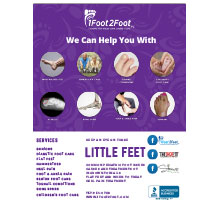Table of Contents
Caring for Little Feet - Introduction
| Age | Check Shoe Fit |
|---|---|
| 1-6 Years | Every 2 months |
| 6-10 Years | Every 3 months |
| 10-12 Years | Every 4 months |
| 12-15 Years | Every 5 months |
| 15-20 Years | Every 6 months |
| >20 Years | Every new shoe purchase |
Common Foot Conditions Among Children
While the fit of shoes is important, there are also a number of foot conditions that are common among children. Some of these conditions include:
Pediatric Flatfoot
Ingrown Toenails
Ingrown toenails are caused by pressure on the side of the nail, causing the nail to deform. The nail can then grow into the skin, creating a puncture wound in the skin that leads to infection. Although it may be tempting to try and address the ingrown toenail at home, this can actually make the problem worse. A quick visit to 1Foot 2Foot can quickly fix this issue with a local anesthetic and removal of a small portion of the nail. You can help to prevent ingrown toenails with the following steps:
- Cut toenails straight across
- Don’t cut toenails too short
- Don’t pick your toenails or tear them at the corners
- Wear shoes with plenty of toe room
- Avoid wearing tight socks or pantyhose
Sever’s Disease/Pediatric Heel Pain
Sever’s Disease occurs when the growth plate in a child’s foot becomes injured. As the foot develops bones grow faster than muscles and tendons, causing these muscles and tendons to become tight. The heel area becomes less flexible and these tight tendons put pressure on the back of the heel, causing injury to the heel and inflammation of the growth plate. This injury is most common in physically active children between 8 and 12 years old. Sever’s Disease can cause limping or tiptoeing and pain in your child’s heel. Your child should be evaluated by a podiatrist to determine a treatment plan. This may include stretching, orthotics, or anti-inflammatories.
While Sever’s Disease is the most common cause of heel pain, it is not the only one. Schedule an appointment with a podiatrist for a thorough evaluation of your child’s heel pain.
Conclusion
Children and teens experience a variety of foot and ankle conditions from those covered above to congenital deformities, sports injuries, and just plain smelly feet. It is essential to monitor your child’s growth and foot health, and it is imperative that you have a podiatrist to guide you as they grow. The doctors and staff of 1Foot 2Foot have the knowledge and experience needed to help your child grow and avoid foot, ankle, and leg pain. Contact us today to schedule an appointment.
Source: Little Feet A Guide to Your Child’s Foot Health
Dr. Michael C. Dairman







